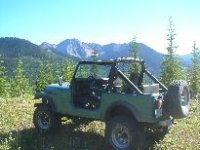a spool connects that shafts together permanently, its like making your front two shafts into one big shaft (simply put) a locker replaces either the spider gears (loc-rite, aussie etc) or the whole carrier (detroit, arb, eaton) and locks you axles together when your on the gas and lets them float when your not. the way an aussie works for example is by using springs and the center pin of the differntial. when its not under throttle the two halfs float, not loose but not bound up so you can turn and it ratchets. when you hit the gas, part of the locker is forced against the center pin, spreading it upen slightly and positivly engaging the ratching teeth so they dont ratchet.
for starters here is an open dif, it transfers power to the wheel with least traction by using the other as a fixed point for the rest of the differential to rotate around. the obvious trail disadvantages are plainly apparent but its action is why it is so good for driving on the road, it doesnt cause uneven wear or weird handling characteristics.
here is a limited slip, you can see that the springs between the spider gears help bias only one tire from spinning, while not fully locking they can be of aid in many situations. they are practically unnoticeable on the road because they do have a point of direct differntation, that is to say at some force the springs are over come and it acts like an open dif, but all in all they are a good selection for moderate trail use. some use clutch packs in the gear sets to do the same things as springs and they usually require a special oil or additive to function correctly
this is a aussie/loc-rite/ez locker/ style locker, you can see the ratching teeth on the two out halfs, and the oval shaped hole for the center pin, the reason for the oval shaped hole is because when you put it under power, the locker rotates slightly and forces the two halfs tight against the outer side gears.
here is the inner workings of a detroit locker (without the case surround it in this picture)
you can see that it works similar to the loc-rite in that it uses two outer teeth to ratcher but since this is in its own case, detroit uses a stronger design, one big center piece and two outer sides that ratchet around it.
here is an air locker, when not actuated it works like an open differential, but when compressed air is sent to the unit, it locks as you can see in the diagram. these are the end all for the locker solution and driving on the road or making sharp corners on the trail, you just hit a switch and unlock it and you get your turning radius back. teraflex also has a new one out, its called the t-locker and is actually supposed to be beefier than the ARB unit. watch for a few seconds, it is actually animated so you can see how it works precisly
here is an electric locker, it uses a special actuator to do something similar to the arb, but uses an external actuator that is integrated into the dif cover to push a shift fork on the inside of the dif (both of these are of the electrac)
this is a cable actuated locker, an ox. they have been used with various success, some people dont like the flex that the cable gives when locking it in, and others have actually changed the cable system over to an air actuator to make it an air locker. this works just the same as the electric style and arb style locker.
here is a spool for a dana 60, the ring gear just bolts on the flange and the axle shafts slide into the two ends, simple and effective but you can see how it adds stress to the drivetrain. theyre great in rear axles because theyre predictable offroad and wont ever unlock at the "wrong moment" but not very practical for everyday driving.
here is a mini spool, same concept as a spool but it just replaces the spider gears (somewhat like a lunch box locker), these are cheap and effective but still act like a spool.
hope that helps you!
-sam








